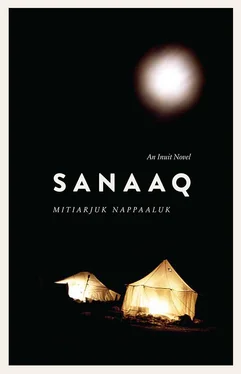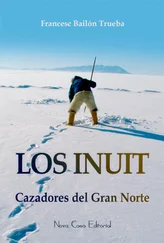Mitiarjuk Nappaaluk
Sanaaq: An Inuit Novel
Sanaaq is an atypical novel. Atypical like its author Mitiarjuk, an Inuk1 from Nunavik (Arctic Quebec) who was illiterate in the sense of being unable to read or write the Roman letters that European languages use and that have recently been adopted for her language. Yet she is deservedly called a writer. She wrote over a thousand pages in syllabics — a kind of shorthand that Wesleyan missionaries created in the late nineteenth century to advance the conversion of the Canadian Cree Indians, who had no writing system of their own. The syllabic alphabet was then adapted by other missionaries to the Inuit language of present-day Nunavik and Nunavut. As new prayer books came into use, it spread quickly through imitation and learning.
Mitiarjuk never went to school. She nevertheless earned a PhD from McGill University in June 2000 for helping advance the teaching of Nunavik’s Inuit language and culture. Her school was the world of her mother and related female elders, who taught the many tasks of women’s traditional work. Less traditionally, her father taught her the secrets of hunting and other male tasks, having no sons and she being his oldest daughter. He was in poor health and often had to let her hunt wild game alone. Culturally and socially, she belonged to a “third sex”2 (or gender), neither male nor female, which gradually made her a mediator between the men and women of her people and between different generations. Perhaps this explains her renowned creativity, as evidenced by the stone carvings that have earned her prestigious awards.
While not shirking the role of a devoted mother (later a grandmother) and wife, she always enjoyed taking part in the political and social debates of her community and even in academic debates, such as at several conferences organized by Inuit Studies. Occasionally, at seasonal camps she always enjoyed rounding out her diet by hunting seals or birds. She was valued by everyone in her home village, men and women alike, and became known far beyond the borders of Quebec and Canada. In 1977, Radio-Canada featured her in the TV series Femmes d’aujourd’hui. In 1999, the National Aboriginal Achievement Foundation awarded her its national prize for excellence and, in 2001, UNESCO honoured her literary works at an international conference of Indigenous writers in Paris.
At the age of sixteen, she was courted by the best hunters of the local bands, being admired for her personal qualities and hunting prowess. The successful suitor was the youngest one. He agreed to live with her parents and take her place as the family’s provider — contrary to the Inuit custom of the wife moving in with the husband’s parents. She devoted the first years of her marriage to her children and husband, at times missing the hunting life. Yet she quickly came to the attention of the local Catholic missionaries, who were studying the Inuit language and translating their prayer books. Her dynamism and familiarity with the local culture made her a valuable assistant. She initially assisted Father Lucien Schneider, O.M.I., in producing his Inuit/French dictionary. She then worked with Father Robert Lechat, O.M.I., who wanted to improve his proficiency in the native language. He provided lined notebooks and asked her to write down sentences, in syllabics, that contained as many terms as possible from daily life. She started writing in her igloo or tent, while the children slept or when free from household chores. But this task grew wearisome. Letting her imagination roam, she created characters and described their fortunes and misfortunes over the different seasons. In short, she recounted the life of a small group of semi-nomadic Inuit families just before the first (Europeans) became established in the region. At twenty-two years of age, Mitiarjuk reinvented the novel, even though she had never read one.
This novel is atypical in more than one way. First, it reflects the author’s initial task of transcribing as many terms and grammatical structures from her language as possible. The vocabulary is thus large (nearly 3,000 words) and highly redundant, as may be seen in the frequent use of synonyms. Second, the novel took almost twenty years to write, for several reasons. The first part covered a little over half of the final manuscript. It stopped at the beginning of episode 24 (The Legend of Lumaajuq) because the author had to leave for a long stay at a hospital in the South and then because Father Lechat had been transferred to Kuujjuaq (Fort Chimo). Father Joseph Méeus, O.M.I., took over supervision of her work and about forty new pages were written, i.e., episodes 25 to 37. The novel continued to remain unfinished with her return to hospital and the transfer of Father Méeus to another village. Mitiarjuk stopped writing for several years.
I met Father Lechat in January 1956 during my first stay in Arctic Quebec. He welcomed me to Kuujjuaq, offering the hospitality of his mission, and told me about the novel Sanaaq. In his hands was the first part, written in pencil with almost nothing crossed out or added. It had been transliterated into Roman letters, with the author’s help, before he had left Kangirsujuaq, and had also been partially translated. But the spelling of the Inuit language had not yet been standardized and the imprecision of syllabic writing, the lack of punctuation, and the distance from the author made the job impossible for him to pursue. He read me some of the translation and my interest was aroused right away. It was not until 1961 that I finally met Mitiarjuk, during anthropological fieldwork at Kangirsujuaq. I convinced her to start writing again. The next year Father Lechat gave me his manuscript of Sanaaq so that I could work on it with Mitiarjuk. This literary work was now the focus of my PhD, the challenge being to make it available to the public. When Father Méeus provided the other part of the manuscript, everything fell into place for what became the final novel.
With the support of Claude Lévi-Strauss, who had been supervising my research from his Laboratoire d’anthropologie sociale in Paris, I was given funding for an eighteen-month mission by the Centre national de la Recherche scientifique (France). I went to Kangirsujuaq in the spring of 1965 with a heavy agenda:
• record Mitiarjuk reading the syllabic version of her manuscript, in order to transliterate it as precisely as possible into standard alphabetical spelling;
• punctuate the text with her help;
• work with her on a line-by-line translation;
• check the transliteration and the translation with the village’s new missionary, Father Jules Dion, O.M.I., who had offered me his assistance;
• ask Mitiarjuk about any difficult passages we might come across;
• record, transcribe, and translate her comments on the text;
• go through the different activities in the novel and observe them in day-to-day Inuit life, to gain a better understanding;
• photograph (or even shoot on 16-mm colour film) the technical operations described in the manuscript; and
• identify the animal and plant species mentioned in the novel, etc.
These activities took me six years, including the time spent working with the author during the summers of 1967, 1968, and 1969. She completed episodes 24 and 38, and added six new ones, nearly sixty new pages, not to mention a sequel to the novel, now being transliterated and translated. In addition, nearly 500 pages of ethnographic commentary were written, transcribed, and translated and now await publication. Father Schneider agreed to read and revise my translations and transcriptions before retiring to Europe. Finally, in 1983 a publishing contract was signed with Mitiarjuk, who asked me to make the necessary arrangements for publication of her work, then in my hands. The first draft of Sanaaq was published by the Association Inuksiutiit (Quebec) with funding from Quebec’s Ministère des Affaires culturelles. It had been rewritten in standard syllabics from my alphabetical transliteration and was lavishly illustrated. While visiting Mitiarjuk in the spring of 1999, I was quite surprised to see the fifty author’s copies she had received in 1984 carefully kept in a cupboard. She intended to have them passed on to her many descendants after her death.
Читать дальше







![Дональд Уэстлейк - Enough [A Travesty (novel) and Ordo (novelette)]](/books/416846/donald-uestlejk-enough-a-travesty-novel-and-or-thumb.webp)




